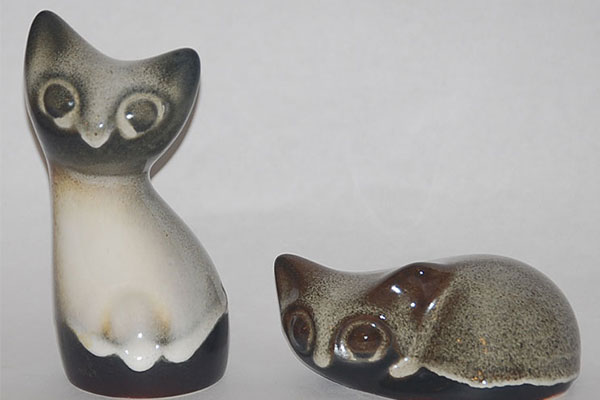Many of our clients don’t realize we have an entire section of other American art pottery. On this page, we feature

.
many pottery makers, including Howard Pierce Pottery. While many of us focus our time and attention (not to mention our money) on some of the more mainstream art pottery companies, there are some gems out there that might not always get the attention they deserve.
Howard Pierce founded his southern California studio in the 1940s after being artistically trained at the Art Institute of Chicago and the University of Illinois. Initially, he’d set up shop in Claremont; however, he eventually settled in Joshua Tree in 1968 – both in California, and in both locations, he enjoyed a robust business that served him well. Most people equate Howard Pierce Pottery with the whimsical figurines such as cats and chickens that were his trademark for many years. He appreciated the dimension a set of uneven heights allowed and as a result, he usually created pairs. The subtle glazes and contrasting shades will draw you in to see the detailing up close and personal. One example of just how intricate the detailing is can be found on the Howard Pierce “Two Chickadees”. There are significant shading efforts, especially on the raised ceramic and they are perfectly placed as only a true artist can accomplish.

Murtle the Turtle - Joshua Tree, CA (Photo courtesy of Potteries of CA)
Most Howard Pierce pottery is marked with his name; however, those smaller pieces are almost never marked in any kind of way. Unlike some of the other American art pottery companies, Pierce initially focused on distributing his wares to local florists, which he would have been content with maintaining. During the mid-1950s, he had received so much positive feedback from the florists and their customers, he decided to take his business to the national level. From there, his porcelain figurines were soon found on store shelves around the country.
After Pierce had relocated his business to Joshua Tree in 1968, he created several large statues for installation in parks and other public areas. Many measured twelve feet or more in height and the vast majority remain in place today, where they are still enjoyed

.
by those who live within the communities they’re housed.
Howard Pierce continued to create his art pottery until his death in 1994.


